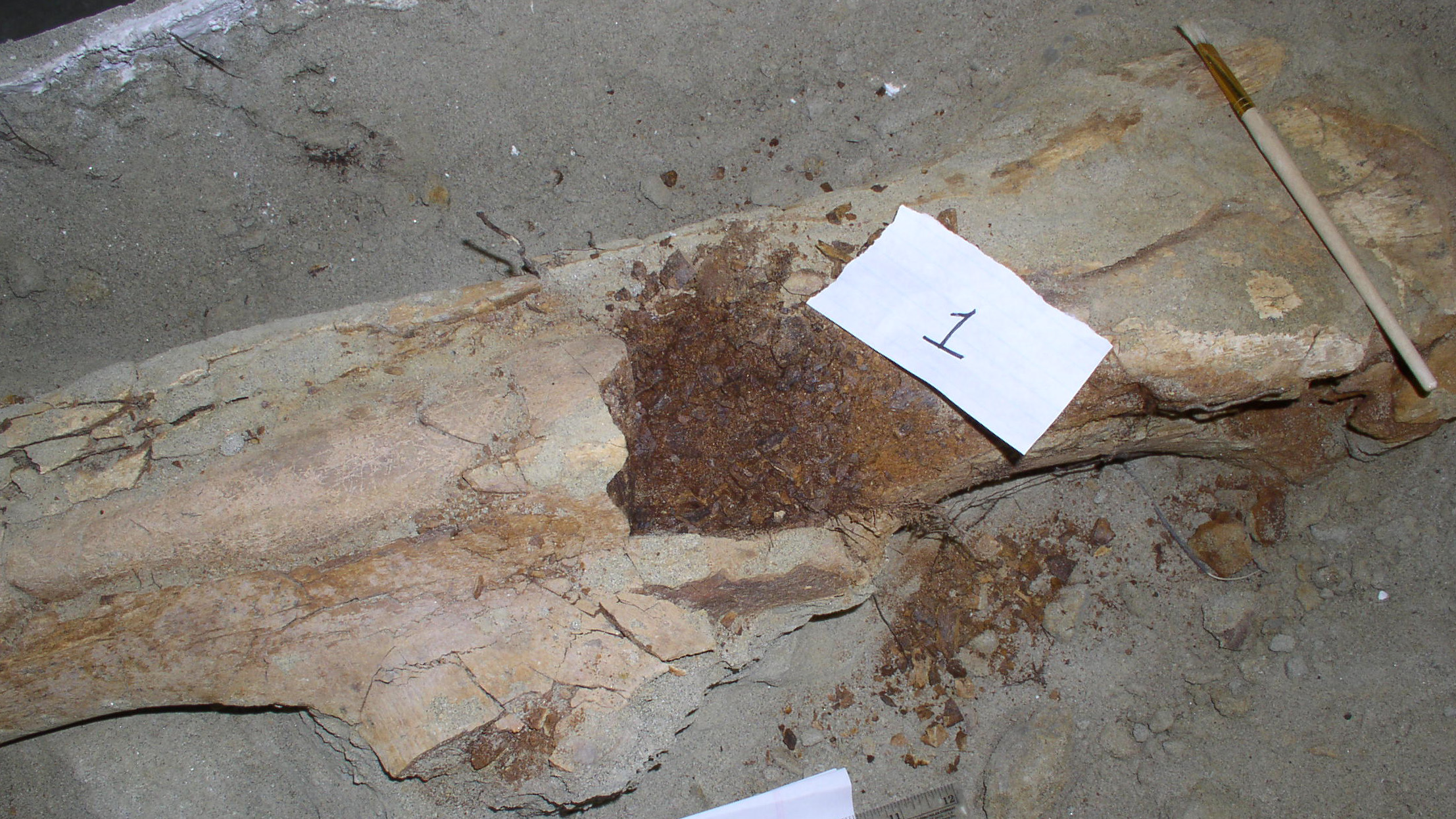80-Million-Year-Old Dinosaur Collagen Confirmed

Utilizing the most rigorous testing methods to date, researchers from North Carolina State University have isolated additional collagen peptides from an 80-million-year-old Brachylophosaurus. The work lends further support to the idea that organic molecules can persist in specimens tens of millions of years longer than originally believed and has implications for our ability to study the fossil record on the molecular level.
Elena Schroeter, NC State postdoctoral researcher, and Mary Schweitzer, professor of biological sciences with a joint appointment at the North Carolina Museum of Natural Sciences, wanted to confirm earlier findings of original dinosaur collagen first reported in 2009 from Brachylophosaurus canadensis, a type of hadrosaur, or duck-billed dinosaur, that roamed what is now Montana around 80 million years ago.
“Mass spectrometry technology and protein databases have improved since the first findings were published, and we wanted to not only address questions concerning the original findings, but also demonstrate that it is possible to repeatedly obtain informative peptide sequences from ancient fossils,” Schroeter says.
Collagen is a protein and peptides are the building blocks of proteins. Recovering peptides allows researchers to determine evolutionary relationships between dinosaurs and modern animals, as well as investigate other questions, such as which characteristics of collagen protein allow it to preserve over geological time (or millions of years).
“We collected B. canadensis with molecular investigation in mind,” Schweitzer says. “We left a full meter of sediment around the fossil, used no glues or preservatives, and only exposed the bone in a clean, or aseptic, environment. The mass spectrometer that we used was cleared of contaminants prior to running the sample as well.”
The sample material came from the specimen’s femur, or thigh bone. Using mass spectrometry, the team recovered eight peptide sequences of collagen I, including two that are identical to those recovered in 2009, and six that are new. The sequences show that the collagen I in B. canadensis has similarities with collagen I in both crocodylians and birds, a result we would expect for a hadrosaur, based on predictions made from previous skeletal studies.
“We are confident that the results we obtained are not contamination and that this collagen is original to the specimen,” Schroeter says. “Not only did we replicate part of the 2009 results, thanks to improved methods and technology we did it with a smaller sample and over a shorter period of time.”
“Our purpose here is to build a solid scientific foundation for other scientists to use to ask larger questions of the fossil record,” Schweitzer adds. “We’ve shown that it is possible for these molecules to preserve. Now, we can ask questions that go beyond dinosaur characteristics. For example, other researchers in other disciplines may find that asking why they preserve is important.”
The research appears in the Journal of Proteome Research and was funded by a National Science Foundation INSPIRE grant. Schroeter is first author of the paper. Co-authors Wenxia Zheng from NC State; Tim Cleland from the University of Texas-Austin; Caroline DeHart, Paul Thomas, and Neil Kelleher from Northwestern University; and Marshall Bern of Protein Metrics, also contributed to the work.
-peake-
Note to editors: An abstract of the paper follows.
“Expansion of the Brachylophosaurus canadensis collagen I sequence and additional evidence for the preservation of Cretaceous protein”
Authors: Elena Schroeter, Mary Schweitzer and Wenxia Zheng, NC State University; Caroline DeHart, Paul Thomas, Neil Kelleher, Northwestern University; Timothy Cleland, University of Texas-Austin; Marshall Bern, Protein Metrics
Published: Journal of Proteome Research
DOI: 10.1021/acs.jproteome.6b00873
Abstract:
Sequence data of biomolecules such as DNA and proteins, which provide critical information for evolutionary studies, have been assumed to be forever outside the reach of dinosaur paleontology. Proteins, which are predicted to have greater longevity than DNA, have been recovered from two non-avian dinosaurs, but these results remain controversial. For proteomic data derived from extinct Mesozoic organisms to reach their greatest potential for investigating questions of phylogeny and paleobiology, it must be shown that peptide sequences can be reliably and reproducibly obtained from ancient fossils, and that fragmentary sequences for ancient proteins can be increasingly expanded. To test the hypothesis that peptides can be repeatedly detected and validated from fossil tissues many millions of years old, we apply updated extraction methodology, high resolution mass spectrometry, and bioinformatics analyses on a Brachylophosaurus canadensis specimen (MOR 2598) from which collagen I peptides were recovered in 2009. We recovered eight peptide sequences of collagen I, two of which are identical to peptides recovered in 2009, and six of which are new. Phylogenetic analyses place the recovered sequences within basal archosauria and when only the new sequences are considered, B. canadensis is grouped more closely to crocodylians, but when all sequences (current and those reported in 2009) are analyzed, B. canadensis is placed more closely to basal birds. The data robustly support the hypothesis of an endogenous origin for these peptides, confirm the idea that peptides can survive in specimens tens of millions of years old, and bolster the validity of the 2009 study. Furthermore, the new data expand the coverage of B. canadensis collagen I (a 33.6% increase in collagen I alpha 1 and 116.7% in alpha 2). Finally, this study demonstrates the importance of reexamining previously studied specimens with updated methods and instrumentation, as we obtained roughly the same amount of sequence data as the previous study with substantially less sample material.
This post was originally published in NC State News.